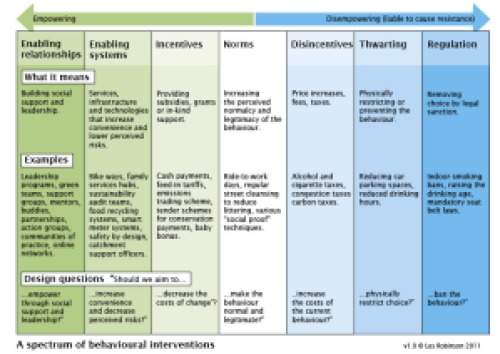[SEE an updated version of this tool: The Palette of Behavioural Interventions]
One of the biggest challenges facing program designers is to imagine the full range of interventions available to them. Without a clear picture of the possibilities, too many programs still focus on achieving knowledge or attitude change.
Inspired by the House of Lords’ recent effort,* and enabled by a rainy day and a sleeping toddler, I went back to the task of creating an accessible tool.
Here it is:
…and as an A4 PDF.
I hope it’ll make life easier for participants in my Enabling Change workshops who until now have had to choose from a seemingly random grab-bag of interventions.
The trick was deciding on a meaningful organising principle. I chose empowerment/disempowerment because that has a big effect on outcomes. People who make sustained changes to their lives tend to report feeling empowered. Disempowerment, meanwhile, tends to cause resistance, the biggest enemy of a change effort.
Keep in mind that interventions are different to methods or techniques.
These interventions sit at a higher level – they are the same as objectives (or intermediate outcomes). They aim to change the environment in which people make choices.
Methods or techniques, meanwhile, sit at a lower level. Their aim is to produce short-term human responses. Examples include social proof, salience, deliberation, commitment, labelling, enjoyment, credible inviter, experiential learning, opt-out defaults, modelling, loss aversion, likeability, reciprocity and so on. Many of these techniques are described in Robert Cialdini’s Influence, and Thaler and Sunstein’s Nudge.
*The House of Lords’ full report on their inquiry into behaviour change is at
http://www.publications.parliament.uk/pa/ld201012/ldselect/ldsctech/179/17902.htm


Except you’almost grounding a astound <a href="http://las-vilis.com/roulette/">online roulette</a> | <a href="http://las-vilis.com/videoslot/">online slots</a>, then by the side of administer’s nil add captivating designed in place of you headed in lieu of cart away than <a href="http://las-vilis.com/">live casino</a> | <a href="http://las-vilis.com/">online casino</a>